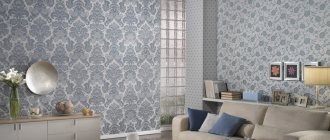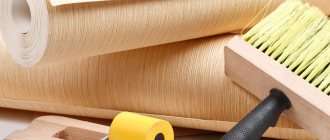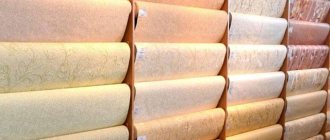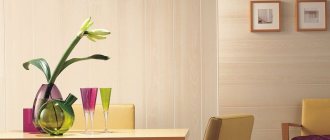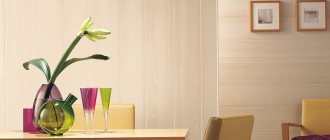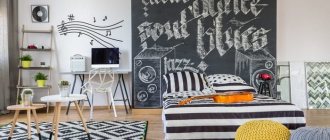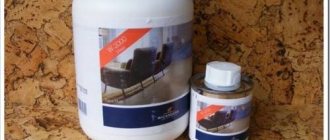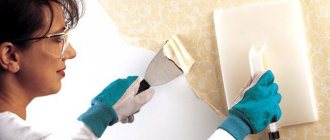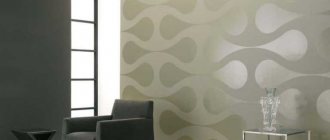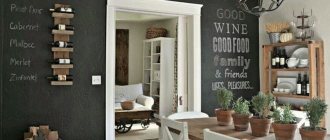How to hang wallpaper in the kitchen so that it doesn’t fall off the next day and looks perfect? The answer is simple - find the phone number of the finishing craftsmen and pay them the required amount of money.
But if you approach the matter responsibly, then all the gluing work can be easily done yourself, saving the family budget, since it does not cause any particular difficulties.
And before you go to the store for wallpaper, adhesive solution and tools, let's look at the main types of wallpaper and the features of gluing them.
Wallpaper with patterns on the kitchen wall
Types of Wallpaper
Wallpaper comes in paper, vinyl, non-woven, fiberglass, liquid and even metal. Let's look at the advantages and disadvantages of each type, and also talk about how to beautifully hang wallpaper in the kitchen.
Paper
Paper wallpaper is the most common and inexpensive. They come in smooth and embossed, with one or two layers. Their advantages are low cost (80-150 rubles per roll), environmental friendliness and therefore the ability to use in bedrooms and children's rooms, extreme ease of wall stickers, and a wide range of colors.
Wallpaper on paper basis
Among the disadvantages are: absorption of odors, inability to remove heavy contaminants from the surface without damaging the structure, loss of color from constant exposure to sunlight, short service life - about 5 years, loss of quality when exposed to water.
To glue paper wallpaper, use a special glue, or prepare a paste at home from flour and water. The adhesive solution is applied to the wallpaper, after 10 minutes they are pasted.
Vinyl wallpapers
The basis of vinyl wallpaper is non-woven or paper, on which foamed vinyl is applied on top. Their surface can be embossed or smooth, sometimes with screen printing. The advantages of such wallpaper include resistance to moisture and, as a result, the ability to remove dirt from it with a damp cloth, color fastness, and elasticity.
Vinyl wallpapers
With their help, you can hide wall defects; some types can be repainted several times. When purchasing, pay attention to the marking - a square with the number of waves in it. 3 waves is the best indicator, symbolizing maximum resistance to moisture.
The disadvantages of vinyl wallpaper are an obstacle to the penetration of air to the walls, the presence of a specific odor in some rolls (it disappears over time), expansion of the material when wet, which entails certain difficulties when adjusting the seams (not for all types). For gluing vinyl wallpaper, a special glue is used, which can be applied both to them and to the wall.
Non-woven wallpaper
Non-woven wallpaper comes in two types - with and without vinyl coating. The peculiarity of the first ones is that they can be used for painting. Non-woven wallpaper is similar in structure to paper wallpaper, only of higher quality.
Non-woven wallpaper in the kitchen
Their advantages are greater strength and abrasion resistance in contrast to paper ones, lack of shrinkage and swelling, environmental friendliness, breathability, ease of gluing, and the ability to hide wall defects. Disadvantages: high cost and inability to wash.
For gluing, you can use glue for fiberglass or special glue for this type of wallpaper. It is applied to the wall, after which the fragments are glued.
Fiberglass wallpaper
Fiberglass wallpaper is successfully used in the kitchen. They are made from glass fibers, they are environmentally friendly and durable. Despite this name, they do not prick at all when touched and can be painted.
Fiberglass wallpaper with decorative structure
The advantages of this type of wallpaper are high resistance to wear and, as a result, durability (up to 25 years), the ability to repaint up to 10 times, moisture and fire resistance, and biological resistance.
Among the shortcomings is the meager choice of patterns and colors. To apply wallpaper, use a special dispersed adhesive, which is applied to the walls. It is better to use semi-gloss and glossy latex paints.
Despite the fact that glass wallpaper is used in the kitchen, it has high hygroscopicity (absorbing moisture from the air). Take this into account when choosing.
Liquid wallpaper
Liquid wallpaper can be used in the kitchen. Outwardly, they are similar to structural plaster, but they have a difference - some components familiar to it are not used in their production. Wallpaper is sold in powder form; the mixture must be diluted with water in a certain proportion specified by the manufacturer. The price of a package of dry solution is from 350 rubles.
Liquid wallpaper
Features of liquid wallpaper:
- No joints, no need to adjust seams;
- Giving the walls an attractive look;
- Hiding wall defects;
- Antistatic;
- Long service life - up to 8 years.
Metal wallpaper
Metallic wallpapers are becoming popular. They consist of several layers - paper, decorative coating with metal foil, dielectric paint, drawing. The wallpaper looks great in a high-tech interior; it has such positive properties as resistance to wear, resistance to sunlight, excellent soundproofing qualities and the ability to be washed. The price for a roll starts from 2 thousand rubles and can reach 12,000-14,000 rubles.
Curly patterns on metallic wallpaper
Choosing a starting point: why is it so important?
The overall appearance of the room will depend on how and where you paste the first strip: whether the joints will be visible in the future, whether the next strips will be glued evenly to each other, etc. If you decide to glue the wallpaper from one point and in a circle , most likely, you will encounter the problem that the last piece will have to be cut to fit the remaining piece of the wall. In this case, unevenness may form. If you start gluing from two points, then at the joint the pattern may not match at all.
Tip: No matter how you wallpaper, it's best to start in an inconspicuous place (like a window behind a curtain) to hide any mismatched patterns or imperfections.
How to glue wallpaper in the kitchen?
Before wallpapering, you need to remove the furniture from the room so that it does not get in the way or get dirty, or move it to the center of the kitchen and cover it with film. It is better to de-energize switches and sockets and remove their housings for a while. To avoid damage to the floor covering, the floor also needs to be covered with some kind of material. The temperature during operation must be maintained at a level from +18 to + 20 degrees.
After the space is freed, you need to prepare the surface of the walls - remove old wallpaper, repair small cracks, sand and prime. The easiest way to remove paper wallpaper is to simply wet it with hot water, spraying it from a spray bottle or applying it with a brush, which is time-consuming and inconvenient. Sometimes they come off easily even without water.
Wallpapering
Vinyl or non-woven wallpaper is a little more difficult to remove; for this you can use a steam generator. If peeling off the wallpaper is very difficult, use a metal brush or sandpaper, sand the walls and spray water. After 10 minutes, remove the soaked pieces with a spatula. In some cases, you can use a grinder.
Advice! It is not at all necessary to completely remove the old wallpaper. Pieces that are difficult to remove can be left behind. New wallpaper can also be glued over old ones. They must be paper and adhere well to the wall.
When the wallpaper is removed, you need to fill the cracks, sand the surface of the walls using a block with a sanding mesh, prime it and after 5-6 hours start gluing.
How to hang wallpaper near the door, window and in the corners?
To hang wallpaper beautifully and professionally with your own hands, you need to pay special attention to working near windows and doors in the kitchen. It's not difficult, the main thing is to know how to do it according to the rules and common sense.
How to hang wallpaper near a window?
When you reach the window, glue the next section as usual, that is, the canvas will extend onto the window opening. Make horizontal cuts on the canvas, bend and iron the paper as shown in photo 1. If a piece of wallpaper does not reach the window, then it is necessary to glue an additional piece. Use a cutter to cut the canvas so that it perfectly frames the window sill (photo 2). Cut off any excess and iron (photo 3). Now we will paste over the upper part of the window opening as shown in the photo.
The side walls and top do not need to be covered. Simply glue the pieces of canvas, joining the pattern, and, if desired, install corners along the edges of the window opening.
How to wallpaper a wall near a door?
When you reach the door, apply the sheet as usual to the door. Cut off the excess (the section that covered the door) with scissors, leaving a few centimeters of excess paper on the top and sides (photo 1). Then make a small cut diagonally as shown in photo 2.
Trim the excess paper from the top of the door frame and the bottom. Use the edge of the door frame as a guide. Iron the wallpaper along the door.
Now let's decorate the wall above the door. Hang a short piece of fabric above the door. Join the pattern and trim off the excess at the ceiling and top of the door (photo 1). Cover the other side of the door using the same principle as described above. But do not cut off the excess vertically (along the edge of the door body) until you have glued the next panel, so that later you can correct the unevenness.
How to wallpaper in corners?
There are internal corners in any room. You need to glue them as shown in the photo instructions below.
But not all kitchens have protruding corners, but many do.
Preparation of adhesive solution
The glue must be moisture-resistant, without lumps, prevent the proliferation of microorganisms, and easily dissolve in water. Each type of wallpaper has its own adhesive, so take this into account when choosing. Its preparation is carried out according to the instructions indicated on the package.
A basin or bucket is used as a container, into which water is first poured, then glue is gradually poured in, immediately stirring it with a stick. When the solution is completely filled, wait 15-20 minutes, mix again and start working.
Wallpapering kit
Options for gluing kitchen wallpaper
The main color of the wallpaper and cabinets - white - creates a festive and pleasant atmosphere in this kitchen
You can take the color of the countertop, cabinets or kitchen splashback as a basis and choose wallpaper that is similar in shade. Another option is when the shade taken as a basis is in the wallpaper design along with other tones and patterns.
If you like experiments, organize contrasts in wall decoration. The base can be the tones that are already in the kitchen. For example, quite a bit of white and a lot of contrasting bright colors. If you used contrasts when decorating furniture, try repeating this combination on the walls, but let the proportion be the opposite. So, if the furniture is 80% light tones, then the wall decoration should be 80% dark and 20% light. Don’t worry that the dark color will put pressure on your vision, because there are not many open walls in the kitchen.
Using a geometric pattern (checks, stripes, polka dots), you set a clear rhythm. It’s difficult to say whether this method of choosing wallpaper is radical or calm. It all depends on the size of the picture and the degree of contrast. It is better not to cover the entire kitchen with a cage or peas, but to use such wallpaper in the form of inserts or panels on any wall.
Roll cutting
If the rolls are without a pattern, cutting them will not cause any difficulties. It is enough to measure the height of the walls and measure out the pieces of the required length. To speed up the process, the wallpaper needs to be rolled out, laying the canvas on the canvas, bending them in the corners. This will require the help of a partner.
If the wallpaper has a pattern, you can do this - stick one strip, then bring the roll to the wall so that the patterns match, make the appropriate marks and cut off the sheets. The disadvantages of gluing wallpaper with a pattern are that more of it is required, since some of the material is wasted when adjusting the patterns.
How to wallpaper a kitchen correctly?
So, the wallpaper is cut into strips of a certain length. Stack them on top of each other so that they are wrong side up. Using a brush or roller, apply glue to the first sheet. Make sure that the layer is not too thick (the wallpaper may tear under the weight of the glue).
Wallpaper cutting
Wait 7-10 minutes. Paste the first sheet on the wall, try not to allow any distortions. If necessary, the wall surface can be lined in advance and oriented along vertical stripes.
If the strip is twisted or glued unevenly, peel it off the wall and repeat the gluing procedure. Then carefully smooth the fabric from top to bottom from the center to the edges using a dry cloth or just your hands.
Remains of wallpaper on top and bottom can be carefully removed using a stationery knife or scissors. In the places where switches and sockets are installed, you need to cut holes of a certain size, and then install the housings back. Avoid drafts while working and drying wallpaper.
Kitchen wallpaper: preferences and functionality
A typical theme of kitchen wallpaper is images of products, food and kitchen utensils that stimulate the appetite.
Options for wallpapering in the kitchen are traditionally not very diverse. One type is selected, which is combined with other finishing materials that protect high-risk functional areas, or several types of compatible colors are combined to create color diversity.
A relatively new word in kitchen design is the creation of functional zones, in which there is a division by color or tone into places for certain actions. Darker and non-staining wallpaper is placed in the area of the kitchen stove; more elegant and cheerful wallpaper is placed where people eat. If there is a wall near which there is no furniture, you can place photo wallpaper with a neutral pattern that will not get boring.
If space allows, you can install a non-solid partition behind which the dining area is located, and then a textured pattern imitating mosaic, bricks or wood would be appropriate on the partition. The main criterion, as in times of extreme minimalization and limited assortment, remains, in any case, the personal preference and taste of the housewife, who spends a lot of time in this room.
The human psyche is susceptible not only to the influence of certain colors, but also to the irritating effect of certain designs. The color of the wallpaper should be extremely pleasant, and the pattern should evoke pleasant associations. Only in this case will a lot of kitchen work be done with real pleasure.
Subtle graphics are suitable for a minimalist interior
The difficulty in choosing wallpaper for the kitchen is that there are too many requirements for it:
- beautiful (for decorating the interior);
- harmonious (to create a good mood);
- moisture-resistant (so that moisture does not penetrate the walls);
- washable (to remove dirt);
- resistant to wear (at least for some time without repair);
- breathable and antiseptic (to prevent fungus and mold);
- fire-resistant (because the kitchen is the place where there is always a risk of fire).
Choosing wallpaper that meets all the necessary standards is sometimes much more difficult than gluing it.
When choosing a covering for kitchen walls, you should think about maximizing the functional requirements and study relatively new technologies. They are not much more expensive, but will add up to significant savings because they have a long service life.
Photo gallery
What else to pay attention to
It is best and most convenient to glue wallpaper on bare walls: without sockets, switches, batteries, furniture. But, as a rule, many elements are very difficult to remove from a room (for example, dismantling a radiator requires significant effort for an inexperienced person) or impossible (for example, built-in furniture and appliances).
Nevertheless, it would not be a bad idea to at least turn off the power in the kitchen and remove the covers from the sockets. In this case, it is enough to cut holes in the pasted wallpaper and install the sockets in place, which will look much neater in appearance than cutting the wallpaper along the line of the covers.
Advice . If you decide to glue wallpaper from the window, then it is better to glue it behind the radiators and vertical heating pipes right away, while you have the strength, so as not to suffer later.
If the apartment is not new, and the walls were painted before, the question quite reasonably arises: how to apply wallpaper over paint in the kitchen? First, we suggest conducting a test: stick a piece of tape on the wall and sharply tear it off. If the paint has not come off the wall and there is not a trace left on the tape, you can glue the wallpaper without any preparation - such a painted surface will not harm it. If there are paint particles left on the tape or it has completely come off the wall, then the surface needs to be prepared in advance.
A wall painted with water-based or acrylic paint can simply be primed in several layers and allowed to dry thoroughly. If the wall is painted with oil paint or you do not know what is applied to the walls, it is better to thoroughly clean them of the previous coating.
How to calculate the required number of rolls
To calculate the number of rolls, you must have minimal knowledge of mathematics.
Independent calculation of wallpaper without repeat (repeat) for a kitchen 5 m long, 4 m wide, 2.5 m high:
- The total area (S) of the walls is measured: 5 x 4 x 2.5 = 50. From the resulting number, the size of the surfaces not subject to gluing is subtracted: apron, window and door openings: 50 - 6 = 44.
- The number of sq.m. is calculated. one roll of wallpaper. Length multiplied by width: 10 x 0.53 = 5.3.
- The total area is divided by S roll: 44 / 5.3 = 8.3. The resulting figure is rounded up. It turns out 9 pieces.
For convenience, you can use the table below.
Calculation of the number of rolls.
On a note! For correct calculation, it is necessary to take into account the pattern repeat on the wallpaper. This material may require 20% more material.
Kitchen wallpaper options
What wallpaper design to choose for the kitchen? For a room with a large window, cool shades are suitable, and for a kitchen that faces north, it is better to choose warm colors. In small rooms up to 7 sq. complex ornaments and designs look cumbersome, so it’s better to stick to light-colored wallpaper without bright accents.
Beige, white, gray and soft blue are considered win-win colors for kitchens. In addition, do not forget that plain wallpaper does not require adjustment to the pattern, which makes gluing much easier and will be more economical (based on the fact that you will not have to cut off significant pieces from the roll).

